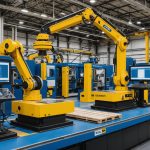Revolutionizing UK Manufacturing: How Digital Twins Enhance Operational Excellence
In the ever-evolving landscape of manufacturing, the adoption of digital twin technology is revolutionizing the way businesses operate, making processes more efficient, reliable, and innovative. This article delves into the world of digital twins, exploring how they are transforming UK manufacturing by enhancing operational excellence.
What are Digital Twins?
Before diving into the benefits, it’s essential to understand what digital twins are. A digital twin is a virtual replica of a physical product, asset, or system. This virtual model is created by outfitting the physical product with sensors that track its functionality, allowing for real-time data collection and analysis[3].
Also to read : Revolutionizing home building: how 3d printing is redefining custom housing construction
Key Components of Digital Twins
- Physical Space and Products: The physical assets that the digital twin represents.
- Virtual Space and Products: The digital model that mirrors the physical asset.
- Digital Thread: The connection between the physical and virtual spaces, enabling real-time data exchange and synchronization[4].
Quality Control and Defect Reduction
One of the most significant advantages of digital twins is their ability to maintain high-quality standards in manufacturing. By monitoring production processes in real-time, digital twins can detect anomalies or deviations from desired specifications and automatically adjust parameters to maintain quality.
Real-Time Monitoring
- Digital twins analyze data from IoT sensors and other sources to identify any deviations from the norm.
- This real-time monitoring enables quick identification of quality issues, allowing for immediate corrective actions[1].
Root Cause Analysis
- Digital twins facilitate root cause analysis, helping manufacturers to quickly identify and address the sources of quality issues.
- This reduces scrap rates and the need for rework, contributing to improved productivity and a higher yield of defect-free products[1].
Improved Decision-Making Through Real-Time Insights
Decision-making in manufacturing is often hampered by fragmented or outdated data. Digital twin technology consolidates and visualizes data in real-time, providing a comprehensive view of operations.
Topic to read : Transforming early disease detection: how graphene-enhanced sensors are leading the charge
Data Analytics and Visualization
- Digital twins use advanced analytics and AI tools to analyze data in real-time, enabling operators to make informed, data-driven decisions quickly.
- For example, if a machine in a production line is operating below its optimal capacity, the digital twin can alert operators, allowing them to take corrective actions[1].
Example: Real-Time Alerts
- At Jubilant Ingrevia, digital twins are used to model, forecast, and manage operations in real time. Specific AI models optimize production parameters, leveraging historical and current data to ensure quality and resource efficiency. This has reduced process variability by 63% and downtime by more than 50%[5].
Process Optimization and Efficiency Gains
In highly competitive manufacturing environments, even marginal improvements in process efficiency can translate into substantial productivity gains. Digital twins can simulate various production scenarios to identify bottlenecks and optimize workflows.
Simulation and Optimization
- Digital twins can simulate how different configurations or production speeds affect output. This capability allows manufacturers to fine-tune processes, achieving an optimal balance between speed and quality while reducing waste and inefficiencies.
- For instance, a digital twin of an assembly line can help manufacturers identify the best production speeds and configurations, leading to productivity improvements of 10-15% or more[1].
Example: Virtual and Smart Factories
- In the aerospace industry, digital twins are used to optimize manufacturing methods by enabling the use of Virtual and Smart Factories. This approach has led to significant reductions in cycle times and improved efficiency, as seen in the success stories shared by Quest Global[2].
Predictive Maintenance and Reduced Downtime
Traditional maintenance models often rely on fixed schedules or reactive approaches, leading to unnecessary maintenance or unplanned downtime. Digital twins can enhance predictive maintenance by monitoring equipment in real-time.
Real-Time Equipment Monitoring
- Digital twins analyze data such as vibration, temperature, and wear to predict potential failures.
- By identifying issues before they become critical, digital twins enable manufacturers to schedule maintenance at optimal times, reducing unplanned downtime and increasing productivity[1].
Example: Extended Equipment Lifespan
- Predictive maintenance supported by digital twins can reduce downtime by as much as 30% and extend the lifespan of equipment. This can lead to significant cost savings, as manufacturers can avoid costly repairs and replacements while keeping production lines running efficiently[1].
Implementing Digital Twin Technology
Implementing digital twin technology requires careful planning and execution. Here are some key considerations:
Define Goals and Scope
- Identify specific productivity goals or problem areas where digital twins can add value. Clear goals will guide the development of a digital twin strategy[1].
Collect and Integrate Data
- Digital twins rely on a continuous stream of data from IoT sensors, PLCs, and other sources. Manufacturers should assess their current data infrastructure and identify gaps that may require additional sensor deployment or data integration tools[1].
Build the Digital Twin Model
- Developing a digital twin involves creating a digital model that accurately reflects the physical asset. This model should include key parameters, operational conditions, and constraints relevant to the manufacturing process[1].
Leverage Advanced Analytics and AI
- To fully unlock the value of digital twins, manufacturers should use advanced analytics and AI tools to analyze data in real-time. These tools can provide insights into patterns, predict failures, and optimize processes, enabling continuous improvement[1].
Key Considerations for Digital Twins
When considering the adoption of digital twin technology, several factors must be taken into account:
Digital Twins are Not Complete Representations
- Digital twins are highly reliant on data input and are not precise representations of physical products. They are akin to algorithms that evolve over time based on the data used to create them[3].
Transparency and Open Formats
- Transparency is critical for smooth digital twin deployment. Data should be easily accessible and exchangeable across different systems and applications. An open format ensures that digital twins can be easily updated, scaled, and extended[3].
Device Management and Cloud Computing
- Manufacturers should ensure their device management plan can keep up with the needs for monitoring, updating, and security. Cloud-based computing, storage, analytics, and AI services can help build, deploy, and grow digital twin solutions quickly and affordably[3].
Real-World Examples and Success Stories
Several companies have already seen significant benefits from implementing digital twin technology:
Jubilant Ingrevia
- Jubilant Ingrevia has widely deployed digital twins to model, forecast, and manage operations in real time. This has led to a 63% reduction in process variability and more than 50% reduction in downtime[5].
Midea Group
- Midea Group has achieved a 25% reduction in development cycles, a 53% reduction in poor quality, and a 29% optimization of logistics paths through the use of AI and digital twins in their manufacturing processes[5].
Aerospace Industry
- In the aerospace industry, companies like Quest Global are using digital twins to identify design issues early, verify interfaces, and conduct simulations. This has resulted in significant reductions in cycle times and improved efficiency[2].
Digital twin technology is a game-changer for UK manufacturing, offering a plethora of benefits that enhance operational excellence. From quality control and defect reduction to process optimization and predictive maintenance, digital twins are revolutionizing the way manufacturers operate.
Practical Insights and Actionable Advice
- Start Small: Begin with a specific area or process where digital twins can add immediate value.
- Invest in Data Infrastructure: Ensure you have a robust data collection and integration system in place.
- Leverage Advanced Analytics: Use AI and machine learning to get the most out of your digital twin data.
- Collaborate Across Supply Chains: Use digital twins to enhance collaboration with suppliers and improve supply chain efficiency.
By embracing digital twin technology, UK manufacturers can stay ahead of the competition, drive innovation, and achieve significant improvements in operational efficiency.
Table: Benefits of Digital Twins in Manufacturing
| Benefit | Description | Example |
|---|---|---|
| Quality Control | Real-time monitoring to detect anomalies and adjust parameters. | Reduced scrap rates and rework at Jubilant Ingrevia[5]. |
| Improved Decision-Making | Consolidates and visualizes data for informed decisions. | Real-time alerts for underperforming machines[1]. |
| Process Optimization | Simulates production scenarios to identify bottlenecks and optimize workflows. | Optimized assembly line configurations[1]. |
| Predictive Maintenance | Monitors equipment to predict failures and schedule maintenance. | Extended equipment lifespan and reduced downtime[1]. |
| Supply Chain Efficiency | Enhances collaboration and visibility across supply chains. | Early identification of supplier issues at Quest Global[2]. |
| Cost Savings | Reduces costs through optimized processes and reduced downtime. | Material cost savings at Beko[5]. |
| Increased Productivity | Improves overall operational efficiency through data-driven insights. | Productivity improvements of 10-15% or more[1]. |
Quotes from Industry Leaders
- “Digital twins simulate the relationship between drug substance properties, process conditions, and product quality to optimize operating conditions,” – Benjamin Schönfuß, Initiatives Specialist, Advanced Manufacturing and Supply chains, World Economic Forum[5].
- “We’ve widely deployed ‘digital twins’ – virtual replicas of critical assets – to model, forecast, and manage operations in real time,” – Anand Laxshmivarahan. R, Chief Digital and Information Officer, Jubilant Bhartia Group[5].
- “The Digital Twin is the concept driver behind Manufacturing 4.0. It moves us from a functional-centric approach to a product-centric one,” – Dr. Michael Grieves, Manufacturing Leadership Council[4].
By understanding and leveraging these insights, UK manufacturers can embark on a journey of digital transformation, enhancing their operational excellence and staying competitive in a rapidly evolving industry.











